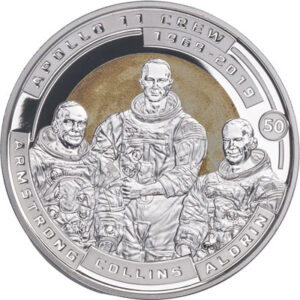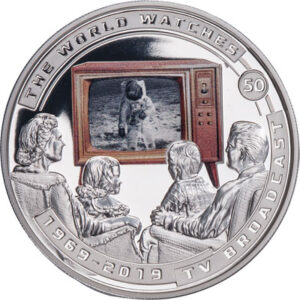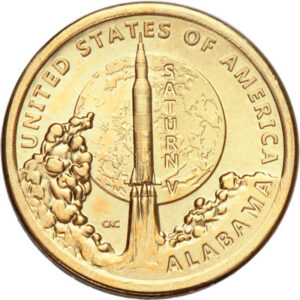Blast off with this Innovation Dollar
On July 20, 1969 a new chapter for mankind began with the steps of two Americans.
Neil Armstrong and Edwin “Buzz” Aldrin’s landing on the Moon as Michael Collins orbited overhead was televised to over 650 million people around the globe. An event that changed the world, their footsteps would go on to inspire future generations.
The road to this historic walk started seven years before Apollo 11 made it to space. In a speech at Rice University, President John F. Kennedy laid out his intentions for the United States to move to the forefront of space exploration.
“We choose to go to the moon in this decade and do other things, not because they are easy, but because they are hard,” Kennedy declared on September 12, 1962. It’s the steps leading up to Armstrong and Aldrin’s giant leap for mankind, that have created the Alabama Innovation dollar design for this year.
Preparing for Lift Off
NASA began work on the Saturn V rocket in August of 1963 at the Marshall Space Flight Center in Huntsville, Alabama. At the time of its launch, the Saturn V rocket became the most powerful rocket to be successfully flown.
Prior to the launch of the Saturn V, each individual stage of a rocket had been tested separately. Now, however, NASA would try a new technique. The crewless rocket tested the “all-up” method where all three stages would be tested at the same time instead of individually. This would help determine the possibility of sending man to the Moon. With baited breath, the world watched as history was made.
Standing at 363 feet tall – the equivalent of a 36-story building – and weighing 6.2 million pounds – as much as 400 elephants – the inaugural launch took place on November 9, 1967. The Saturn V rocket, a Heavy Lift Vehicle (a vehicle that needs a large amount of force to take off), created 7.6 million pounds of thrust to lift off. That means with the launch of just one rocket more than 85 Hoover Dams worth of power was generated!
Walter Cronkite excitedly broadcast the epic launch to millions of Americans from the Kennedy Space Center in Florida. The force of which was so strong that Cronkite had to stand up in the middle of the broadcast to hold a window from falling on his head.
The Aftermath
Once the initial test of the Saturn V rocket proved to be a success, the next six years would see an additional twelve rockets make their way to the final frontier.
Another two flights would be made the following year in 1968: the first was another test while the second was the first manned launch into lunar orbit. Finally – in July of 1969 – the culmination of six years of hard work would pay off as Apollo 11 made its epic launch.
After six successful landings on the Moon, and the Apollo 13’s unsuccessful attempt in 1970, the technology used for the Saturn V rocket was retired in 1973. Now with the Alabama Innovation dollar design, the Saturn V rocket has found its way not only into outer space but also into coin collections.
While this historic rocket is no longer used to bring man to the Moon, it still provides Americans unrivaled pride in accomplishing the impossible. This sense of triumph is honored with the Alabama Innovation dollar design. Found front and center on the coin’s reverse is the Saturn V rocket lifting off in front of the Moon.
Celebrate this impressive feat of innovation with the Uncirculated Philadelphia “P” and Denver “D” Mint or Proof San Francisco “S” Mint Innovation dollars from Alabama.
Where were you when the first launch of the Saturn V rocket was made? Are you caught up on your Innovation Dollar collection? Tell us in the comments below!
Sources:
NASA. “55 Years Ago: Apollo 4, the First Flight of the Saturn V” Accessed May 1, 2024 https://www.nasa.gov/history/55-years-ago-apollo-4-the-first-flight-of-the-saturn-v
NASA. “What Was the Saturn V? (Grades 5-8)” Accessed May 1, 2024 https://www.nasa.gov/learning-resources/for-kids-and-students/what-was-the-saturn-v-grades-5-8
Historic Spacecraft. “Saturn V Rocket” Accessed May 1, 2024 https://historicspacecraft.com/Rockets_Saturn_5.html







I WOULD order this, but your minimum $6.95 shipping fee is RIDICULOUS! Count me out from ever ordering anything from you!
Sorry you feel that way Steve. Our flat shipping & handling fee is for more than just postage. It allows us to guarantee delivery to our customers. In the event a shipment of coins was to go missing in the mail, that fee allows us to resend your order with no additional cost to you.
Bear in mind we do regularly offer free shipping & handling on online orders. Currently, orders of $100 or more online will receive free shipping & handling.